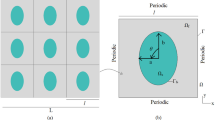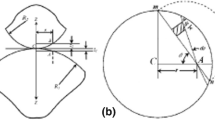Abstract
In this paper we provide numerical verification on the cross-property connection between effective fluid permeability and effective electrical conductivity. A set of 10 different microstructural patterns has been generated using a molecular dynamics algorithm. The problems are solved numerically using homogenous boundary conditions. The volumetric average over a cubic volume is used to obtain with the effective electrical conductivity and the effective fluid permeability. The tortuosity of the porous phase τ p was estimated by assuming a non-conductive solid phase, the inverse problem was solved to get the tortuosity of the matrix τ s . The accuracy of the cross-property connection developed by Sevostianov and Shrestha (2010) is verified, an error of less than 1% is found.
Similar content being viewed by others
References
Archie G.E. (1941) The electrical resistivity log as an aid in determining some reservoir characteristics. Trans. Am. Inst. Min., 146: 54–62
Avellaneda M., Torquato S. (1991) Rigorous link between fluid permeability, electrical conductivity, and relaxation times for transport in porous media. Physics of Fluids-A, 3(11): 2529–2540
Beran M.J. (1965) Use of the variational approach to determine bounds for the effective permittivity in random media. Nuovo Cimento, 38(2): 771–782
Beran M.J. (1968) Statistical Continuum Theories. Wiley, New York
Berryman J.G., Milton G.W. (1988) Microgeometry of random composites and porous media. Journal of Physics D: Applied Physics, 21(1): 87
Bristow J.R. (1960) Microcracks, and the static and dynamic elastic constants of annealed heavily cold-worked metals. British J. Appl. Phys, 11(2): 81–85
Carman P.C. (1939) Permeability of saturated sands, soils and clays. The Journal of Agricultural Science, 29(2): 262–273
Cherkaev A., Gibiansky L. (1992) The exact coupled bounds for effective tensors of electrical and magnetic properties of two-component two-dimensional composites. Proc. Roy. Soc. Edinburgh, A 122: 93–125
Cornell D., Katz D.L. (1953) Flow of gases through consolidated porous media. Industrial and Engineering Chemistry, 45(10): 2145–2152
Costamagna P., Costa P., Antonucci V. (1998) Micro-modeling of solid oxide fuel cell electrodes. Electrochimica Acta, 43(3–4): 375–394
Costamagna P., Costa P., Arato E. (1998) Some more considerations on the optimization of cermet solid oxide fuel cell electrodes. Electrochimica Acta, 43(8): 967–972
Darcy H. (1856) Les fontaines publiques de la Ville de Dijon. Victor Dalmont, Dalmont
Gibiansky L. V., Torquato S. (1993) Link between the conductivity and elastic moduli of composite materials. Physical Review Letters, 71(18): 2927–2930
Huet C. (1984) On the defnition and experimental determination of effective constitutive equations foe assimilating heterogeneous materials. Mechanics Research Communications, 11(3): 195–200
Kachanov M., Sevostianov I. (2005) On quantitative characterization of microstructures and effective properties. International Journal of Solids and Structures, 42: 309–336
Perkins, F. M., Osaba, J. S., and Ribe, K. H. (1956). Resistivity of sanstones as related to the geometry of their intersticial water. Geophysics, XXI(4):1071–1084.
Prager S. (1969) Improved variational bounds on some bulk properties of a two-phase random medium. Journal of Chemical Physics, 50(10): 4305–4312
Schwartz L.M., Martys N., Bentz D., Garboczi E.J., Torquato S. (1993) Cross-property relations and permeability estimation in model porous media. Physical Review E, 48(6): 4584–4591
Sevostianov I., Kachanov M. (2002) Explicit cross-property correlations for anisotropic two-phase composite materials. Journal of the Mechanics and Physics of Solids, 50(2): 253–282
Sevostianov I., Kachanov M. (2008) Connections between elastic and conductive properties of heterogeneous materials. Advances in Applied Mechanics, 42(2009): 69–252
Sevostianov I., Shrestha M. (2010) Cross-property connections between overall electric conductivity and fluid permeability of a random porous media with conducting skeleton. International Journal of Engineering Science, 48(12): 1702–1708
Sevostianova E., Leinauer B., Sevostianov I. (2010) Quantitative characterization of the microstructure of a porous material in the context of tortuosity. International Journal of Engineering Science, 48(12): 1693–1701
Skoge M., Donev A., Stillinger F.H., Torquato S. (2006) Packing hyperspheres in high-dimensional Euclidean spaces. Physical Review E, 74(041127): 1–11
Torquato S. (1990) Relationship between permeability and diffusion-controlled trapping constant of porous media. Physical Review Letters, 64(22): 2644–2646
Torquato, S. (2006). Random Heterogeneous Materials. Springer-Verlag .
Torquato S., Kim I.C. (1992) Cross-property relations for momentum and diffusional transport in porous media. Journal of Applied Physics, 72(7): 2612–2619
Wiegel F.W. (1980) Fluid flow through porous macromolecular systems. Springer-Verlag, Berlin Heidelberg New York
Winsauer W.O., Shearin H.M., Masson P.H., Williams M. (1952) Resistivity of brine-saturated sands in relation to pore geometry. AAPG Bulletin, 36(2): 253–277
Wyllie M.R.J., Rose W.D. (1950) Some theoretical considerations related to the quantitative evaluation of the physical characteristics of reservoir rock. Petroleum Transactions, AIME, 189: 105–118
Zohdi T.I. (2001) Computational optimization of the vortex manufacturing of advanced materials. Comput. Methods Appl. Mech. Engrg., 190(46–47): 6231–6256
Author information
Authors and Affiliations
Corresponding author
Rights and permissions
About this article
Cite this article
Garcia, J.R., Sevostianov, I. Numerical Verification of the Cross-Property Connections Between Electrical Conductivity and Fluid Permeability of a Porous Material. Int J Fract 177, 81–88 (2012). https://doi.org/10.1007/s10704-012-9740-0
Published:
Issue Date:
DOI: https://doi.org/10.1007/s10704-012-9740-0




